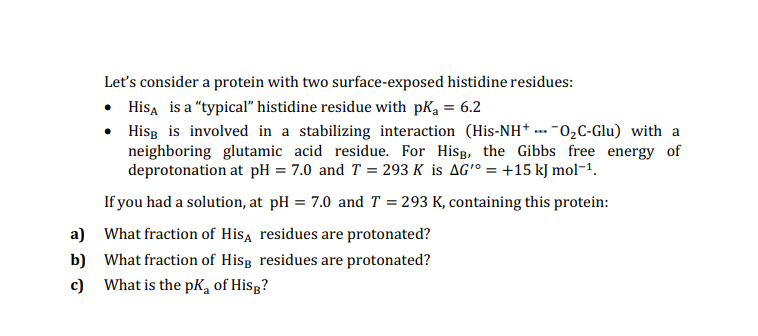Let's consider a protein with two surface-exposed histidine residues: • Hisa is a "typical" histidine residue with pK = 6.2 • Hisg is involved in a stabilizing interaction (His-NH* --- -0,C-Glu) with a neighboring glutamic acid residue. For Hisg, the Gibbs free energy of deprotonation at pH = 7.0 and T = 293 K is AG'º = +15 kJ mol-1. If you had a solution, at pH = 7.0 and T = 293 K, containing this protein: a) What fraction of Hisa residues are protonated? b) What fraction of Hisg residues are protonated? c) What is the pK, of Hisg?
Let's consider a protein with two surface-exposed histidine residues: • Hisa is a "typical" histidine residue with pK = 6.2 • Hisg is involved in a stabilizing interaction (His-NH* --- -0,C-Glu) with a neighboring glutamic acid residue. For Hisg, the Gibbs free energy of deprotonation at pH = 7.0 and T = 293 K is AG'º = +15 kJ mol-1. If you had a solution, at pH = 7.0 and T = 293 K, containing this protein: a) What fraction of Hisa residues are protonated? b) What fraction of Hisg residues are protonated? c) What is the pK, of Hisg?
Biochemistry
9th Edition
ISBN:9781319114671
Author:Lubert Stryer, Jeremy M. Berg, John L. Tymoczko, Gregory J. Gatto Jr.
Publisher:Lubert Stryer, Jeremy M. Berg, John L. Tymoczko, Gregory J. Gatto Jr.
Chapter1: Biochemistry: An Evolving Science
Section: Chapter Questions
Problem 1P
Related questions
Question

Transcribed Image Text:Let's consider a protein with two surface-exposed histidine residues:
• Hisa is a "typical" histidine residue with pKa = 6.2
Hisg is involved in a stabilizing interaction (His-NH* --- -02C-Glu) with a
neighboring glutamic acid residue. For Hisg, the Gibbs free energy of
deprotonation at pH = 7.0 and T = 293 K is AG'° = +15 kJ mol-1.
If you had a solution, at pH = 7.0 and T = 293 K, containing this protein:
a) What fraction of Hisa residues are protonated?
b) What fraction of Hisg residues are protonated?
c) What is the pK, of Hisg?
Expert Solution
This question has been solved!
Explore an expertly crafted, step-by-step solution for a thorough understanding of key concepts.
This is a popular solution!
Trending now
This is a popular solution!
Step by step
Solved in 4 steps

Knowledge Booster
Learn more about
Need a deep-dive on the concept behind this application? Look no further. Learn more about this topic, biochemistry and related others by exploring similar questions and additional content below.Recommended textbooks for you

Biochemistry
Biochemistry
ISBN:
9781319114671
Author:
Lubert Stryer, Jeremy M. Berg, John L. Tymoczko, Gregory J. Gatto Jr.
Publisher:
W. H. Freeman

Lehninger Principles of Biochemistry
Biochemistry
ISBN:
9781464126116
Author:
David L. Nelson, Michael M. Cox
Publisher:
W. H. Freeman

Fundamentals of Biochemistry: Life at the Molecul…
Biochemistry
ISBN:
9781118918401
Author:
Donald Voet, Judith G. Voet, Charlotte W. Pratt
Publisher:
WILEY

Biochemistry
Biochemistry
ISBN:
9781319114671
Author:
Lubert Stryer, Jeremy M. Berg, John L. Tymoczko, Gregory J. Gatto Jr.
Publisher:
W. H. Freeman

Lehninger Principles of Biochemistry
Biochemistry
ISBN:
9781464126116
Author:
David L. Nelson, Michael M. Cox
Publisher:
W. H. Freeman

Fundamentals of Biochemistry: Life at the Molecul…
Biochemistry
ISBN:
9781118918401
Author:
Donald Voet, Judith G. Voet, Charlotte W. Pratt
Publisher:
WILEY

Biochemistry
Biochemistry
ISBN:
9781305961135
Author:
Mary K. Campbell, Shawn O. Farrell, Owen M. McDougal
Publisher:
Cengage Learning

Biochemistry
Biochemistry
ISBN:
9781305577206
Author:
Reginald H. Garrett, Charles M. Grisham
Publisher:
Cengage Learning

Fundamentals of General, Organic, and Biological …
Biochemistry
ISBN:
9780134015187
Author:
John E. McMurry, David S. Ballantine, Carl A. Hoeger, Virginia E. Peterson
Publisher:
PEARSON